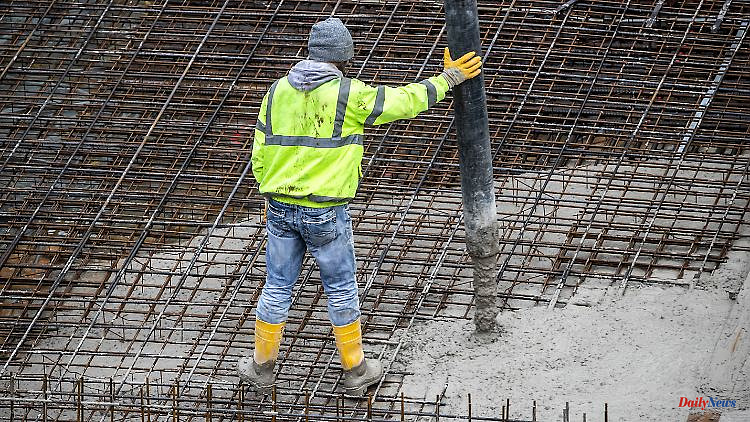Whichever construction site you look at, nothing works without cement. The ancient Romans already knew that. Hundreds of years ago they made cement clinker from limestone, mixed it with water and gravel to form concrete and built bridges, houses, the Pantheon and the Colosseum from the malleable "ready-made stone". However, the most versatile material in the world is also the dirtiest: the cement industry blows as much carbon dioxide into the atmosphere as India. And unlike many other industries, little can be done about it. Because there is currently no alternative in sight for the manufacturing process, as Peter Schniering explains in the interview. At the same time, demand will remain extremely high in the coming decades, especially in developing countries. And recycling? It's next to impossible. "I consider the cement industry to be the most complex problem area of the climate crisis," says the founder of Future Cleantech Architects (FCA), summing up the frustrating situation in ntv's "climate laboratory".
ntv.de: If the cement industry were a country, it would have the third highest CO2 emissions after China and the USA. What makes cement so dirty?
Peter Schniering: That has to do with a number of factors. The demand for cement for the modern infrastructure of cities is extremely high. In addition, the cement process, calcination, has very high process emissions. Unlike in many other areas, however, they do not come from firing with the fuel. That's why little can be changed about it.
calcination?
Yes. The basis of cement is limestone. It is available in abundance worldwide and has been used for many buildings for thousands of years. Even the Romans used it to produce cement clinker at comparatively low temperatures. Today's main product, Portland cement, on the other hand, is manufactured at very high temperatures of 1200 to 1500 degrees, sometimes even 1800 degrees. This cement clinker is the basis of concrete, which is what the end product is about. During calcination, however, the CO2 bound in the limestone is dissolved and released into the atmosphere.
So you have a double burden? The limestone causes CO2 emissions when dissolved. In addition, there are emissions that occur during the firing process and the high temperatures?
Correct. The proportion of CO2 that is released from the limestone is around 60 percent. The fuel used for firing adds 30 percent. The remaining 10 percent comes from the grinding process and transport. Unfortunately, there is no real alternative to the emissions from calcination. The high temperatures are also a problem because you can't easily power the process with low temperatures or renewable energy.
But you said the Romans used lower temperatures.
How exactly one landed at these high temperatures can be better explained by a cement historian. But in the end it's economic reasons, there's enormous cost pressure in the industry. For this reason, the dominant Portland cement has been refined and optimized over many decades. For the optimal purity of the material, the high-temperature process is the best and most efficient process. In ancient times, cement clinker was made at temperatures around 200 degrees. Thus, the Roman concrete was not so pure. However, a new study found that this actually had advantages for the aging of the material and long-term durability.
So cement made at lower temperatures lasts longer?
That's simplified, but yes.
So why isn't it used anymore today?
Leaving aside climate impact, cement and concrete have a number of major benefits. Only water is used more as a material worldwide because concrete is cheap and completely flexible to form. In English one also speaks of "instant stone", i.e. ready-made stone: You stir the concrete, position it and it becomes solid. In addition, he can withstand enormous pressure. I'm not an expert on antique concrete, but it's significantly weaker, more reliable, and probably doesn't conform to modern building codes. You don't want to use it for sewers or foundations.
How is the demand developing? Do we use more cement or less?
That has steadily increased. When it comes to projecting future consumption, there are different forecasts: The International Energy Agency (IEA) assumes that global demand will increase by 12 to 20 percent by 2050. The global cement and concrete association GCCA is more pessimistic and expects an increase of up to 40 percent. A study by Nature Materials even expects an increase of up to 50 percent.
But this is about the construction work. States, cities or investors do not project cement consumption, but buildings, sewers and bridges do. Maybe it can be delivered in a different way.
Where is this great demand coming from?
A large part comes from the developing world. From regions and emerging countries that want to urbanize - be it in Africa, Latin America or Southeast Asia. Concrete plays an incredibly important role in the desire to increase the quality of life with infrastructure.
Are there alternatives to enable a similar construction work?
If you don't want to tell these countries that they can't use concrete anymore, there are four options, all of which only partially help: You can reduce demand by using alternative building materials. A second point is CCS, i.e. carbon capture and storage: the CO2 is cut off in cement production and stored somewhere. Then we have the high process temperature, we call it "The Flame": Is electrical firing with renewable energies possible? Is it okay with lower temperatures? But this research is still in its infancy.
The fourth possibility, but by no means the least important, are alternative materials: can we also produce cement and concrete without limestone? This field also includes the idea of recycling concrete.
Wouldn't that be a possibility? When you walk through a big city, you see quite a lot of rubble that could be reused.
The best thing would be not to demolish buildings at all, but to preserve, renovate or modernize the old stock. Because it is virtually impossible to break down existing concrete into its basic elements and reuse the cement. The final concrete mass also contains water, gravel and many other things. That's what makes it so difficult: Unlike with glass, you don't get back pure raw materials. And even if you do, the recycling process would also consume a lot of energy. The decabonization potential is low.
And where do these materials end up? Just in the dump? In China, several building shells have just had to be demolished.
That depends strongly on the regulation in the respective country and of course on the construction method. A bridge that has been reinforced with steel is a completely different challenge than a single family home.
But isn't that utter madness: we just keep making stuff we don't know how to reuse, dispose of or replace?
I don't want to seem disillusioned, but that's the challenge. Prefabricated parts could be used for newer buildings. You can disassemble these pre-cast concrete elements afterwards and use them elsewhere like Lego blocks. But that is difficult with individualized structures such as bridges, because they often have to be adapted to the topography. If you want to reuse concrete, you have to break it, smash it, tear it down. You get rocks, but no cement.
So you could just reuse individual parts, is that all?
No, we have other levers. A very important one is CCS. Independent of the cement industry, we definitely have to do our homework in this area. Another important lever are building regulations. Of course, a bridge should be rock solid, but most of the time cement and concrete are used in abundance to be on the safe side. If the fire protection standards are also relaxed, more wood can be used as a building material in the future. At the same time you have to think of buildings differently and build as many as possible modularly so that you can dismantle them again.
Which of these parameters has the greatest potential?
That's hard to say because we're still in the basic technological research. But if we look to 2050, we can hope that there is still something in the innovation pipeline that we have not yet considered: an alternative material instead of cement.
That doesn't sound particularly reassuring.
As an organization, we focus on industry segments that are the most difficult to decarbonize. These are sectors with high emissions and a low level of technology maturity. That is my personal assessment, but I consider the cement industry to be the most complex problem area of the climate crisis.
But even if an alternative material were found, the problem would have been solved primarily in Germany and Europe, but neither the price nor the demand in developing countries would have been reduced.
Yes. This Portland cement in particular has become a global raw material because it is very, very cheap. A lot is happening at the moment, we are part of the research consortia of the cement manufacturers. But even in countries like Germany, where there is financial support, decarbonization requires a huge culture shift. If you talk to cement manufacturers in countries that are still developing and where there is enormous price pressure, they tell you: We cannot afford to convert our cement plants. And consumers ultimately don't care whether the concrete was produced in a climate-neutral or climate-friendly manner.
I'm still optimistic. Of course, one cannot rely on finding an alternative building material. But ten years ago nobody would have expected that lithium-ion batteries would cost so little or that we could produce solar power for 1 cent per kilowatt hour, depending on the region and the technology. Everyone would have said I was crazy.
Clara Pfeffer and Christian Herrmann spoke to Peter Schniering. The conversation has been shortened and smoothed for better understanding.












